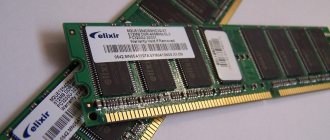What is RAM in a phone
RAM or random access memory is short-term digital storage. It is available in almost all devices, not just mobile phones. Computers and smartphones use RAM to store data that an application accesses while running. There are many requirements for this module, among which volume is considered the most important. It differs from the drive in its high read and write speed.
When considering what RAM is in a phone, it is worth considering that such memory is much faster than any flash memory. The central processor of mobile devices has its own cache for storing temporary files. But in most cases this is not enough. Even the latest Qualcomm Snapdragon model can't run without RAM.
The operation of a mobile phone occurs according to the following scheme. It is as follows:
- The operating system kernel acts as a coordinator.
- When the application starts, all data goes into RAM.
- Some of the information is analyzed and the processor is connected along with the graphics core.
Only after this the information is displayed on the device screen. Information about what RAM is in a smartphone indicates the importance of this element. Many people take this indicator into account when choosing a mobile phone.
This block is represented by a small chip. Moreover, it operates at different frequencies. It will not be possible to expand it due to the soldering on the board.
What does this information tell us?
Better understanding when choosing a smartphone. As you already understand, Apple has no problems with this, so you can buy what you like and not worry. The main thing is not to take something very ancient, where there will not be enough RAM or processor power.
If we talk about options based on the Android OS, then in a budget device you don’t have to worry about the type of memory; its quantity will be more important. By mid-2022, 3–4 GB will be considered the norm for an inexpensive device. Two is also possible, but open applications and browser tabs will be constantly reloaded due to lack of memory. And after six months or a year of use, it will work noticeably slower.
In powerful devices, LPDDR4 with a capacity of 6–8 GB is quite enough. So that you can launch games and applications in the tray without rebooting, and maintain the overall speed of the system.
In top-end camera phones that require complex video shooting, it is best to look at LPDDR4x options with a capacity of 8–12 GB.
Smartphone internal memory
Built-in memory is one of the most important parameters of any smartphone. Its volume determines how many applications and games you can install, how many photos and videos you can take, and what will be left after that for storing music, documents, e-books and other downloaded content.
Why do you need RAM?
When you exit the application or when you restart the smartphone, all information is erased. All important data is overwritten on the drive.
The operating system also requires fast memory to use information. Mobile device manufacturers try to add it so that the OS runs smoothly. What is RAM in a smartphone - a data storage center for fast processing.
There are several processes that use RAM at the time of the first launch. They are as follows:
- Virtual files. If you look for information on what a phone's RAM is, you will find information about the creation of separate files to display information about processor speed and battery charge. The Android operating system stores such data in the proc directory. Free space is reserved for them.
- Core. It is stored in a special compressed file, which is extracted when the device is turned on. Requires a large amount of RAM to retrieve drivers and other information. They are needed to control the phone.
- Graphics processor. When considering what RAM is in a smartphone, it should be taken into account that after calculating the necessary information, the graphics core is responsible for displaying the data. It has built-in VRAM memory. However, only expensive smartphones have it. Therefore, the kernel sends data to RAM.
- Communication and information. There are certain data that are not erased when the phone is rebooted. Considering what the phone's RAM is, you need to pay attention to the presence of NVRAM. It stores communication settings. From time to time, information is exchanged with RAM.
- System cache. It is created during the operation of the main applications. Located in the cache folder. You should not influence it, as this will disrupt the operation of the operating system and all programs.
- Application cache. It is generated by all the software that is installed on the device. The cache is loaded into RAM only when the application is launched. These files are cleaned manually or using special software.
A large number of different shells are created for Android. For example, Samsung Galaxy has its own hidden processes that load information into RAM. They reserve a certain space at the time the smartphone starts. This moment determines why the user does not have access to all the space.
How and how much RAM is consumed by the system?
Operating systems of mobile platforms, such as Android and iOS, are sufficiently optimized and balanced. That is, the distribution of resources in them occurs in the most rational way. The developer of each specific application is responsible for excess consumption of RAM. If his product is not optimized and allows memory leaks, then any smartphone will not have enough RAM.
Any operating system can be supplied either in its pure form or in the form of proprietary shells from the manufacturer. Accordingly, the latter may require much more resources. On average, the Android operating system consumes about 500 megabytes in its pure form. If additional shells are installed on top of it, then this figure can be safely multiplied by 2, or even 3. Also, various innovative functions and capabilities can affect the consumption of RAM in the phone. For example, various mechanisms for identifying faces and fingerprints.
How to find out how much memory is on your device
After determining what RAM is in a smartphone, you need to check how much memory there is. To do this, follow the following procedure:
- for a device that runs on the Android platform, you need to download a special CPU-Z program or another tester from the official Play Market store;
- for the iOS operating system, the AppStore has the Antutu Benchmark program;
After opening the program, a list of information opens, among which there is a RAM section. Similar data is included in the operating instructions or in the description that is printed on the box.
It is not enough to know what the phone's RAM is. She needs to be controlled. Insufficient volume becomes the reason why problems arise when starting the program, and the phone begins to reboot. Find out the amount of RAM in several ways:
- for OS Android, the Clean Master application is installed, in the main menu there is an “Application Manager” item and information about the used memory;
- iOS has special programs, for example, “The System from the Inside” by Anna Negara.
Some devices have their own shell with a task manager. It allows you to quickly free up RAM and storage space.
Optimal smartphone memory parameters
Before buying a new smartphone or tablet, you need to decide on your potential needs and how you plan to use the gadget.
Depending on this, it is worth choosing a model that meets at least the minimum threshold for the amount of RAM and internal memory.
Saving when buying a cheaper device with less RAM or built-in memory will lead not only to discomfort when working with a smartphone, but also to an immediate need to purchase a new device.
Device RAM capacity
If we consider RAM, the required amount directly depends on the type of use of the device:
- what programs and applications the smartphone owner plans to use,
- how many simultaneously running processes does it need,
- For what purpose do you plan to use the device?
When choosing a smartphone, you need to remember that it is impossible to increase the amount of RAM: if the load on the device increases, the only possible way to get large amounts of RAM is to buy a new phone.
Let's take a closer look at what characteristics a smartphone with a specific amount of RAM will have:
- 512 MB - this RAM capacity is most often found in budget models, as well as older phones. Nowadays, RAM of this size will not be enough for comfortable work with the gadget: it is suitable for those who use smartphones for calls or one-time tasks.
- 1 GB - in the second decade of the 20th century, this amount of RAM was considered minimal for the full functioning of a phone. The device will be able to support up to 5 applications simultaneously, which will allow it to be used not only for calls, but also for accessing the Internet and communicating in several instant messengers.
- 2 GB - today this is the optimal amount of RAM, typical for budget smartphones. The memory is enough to run up to 10 applications and games at low speeds. Increasing the load will lead to a significant decrease in the performance of the gadget.
- 3 GB - RAM is designed for multifunctional operation. The owner of the device will be able to run “heavy” applications and utilities without any problems, install animated launchers, and play online games without any problems.
- 4 GB - a smartphone with this amount of memory “does not work, but flies.” For ordinary users, it is more than enough: the phone will be able to simultaneously support up to 30 open programs, and applications will launch instantly. 4 GB RAM is typical for flagship models of prestigious brands in the high price segment.
- 6 GB is the maximum possible amount of RAM. Found on a few models of the latest generation smartphones. Purchasing a gadget with such characteristics does not bring much practical benefit: to fully load the RAM, you will need to activate over 100 programs simultaneously.
How much RAM do you need?
When considering what RAM is in a phone, you need to take into account its recommended volume. It performs the same function as in a computer. Multitasking requires more volume. If you run several heavy applications at once with 4 GB, the device starts to slow down a lot and may turn off. The ability of the smartphone to return to a previously started process at any time is significantly reduced. When you place another data file, Samsung Galaxy begins to upload others.
Some users say that they do not need many GB of RAM. Therefore, an illustrative study was conducted by one of the popular resources, Android Authority. Most of the most common games use up to 400 MB, but only the most complex projects eat up a gigabyte. Instant switching between PUBG is rarely required.
In most cases, 3 GB of memory is sufficient. Taking into account the shell and Android used, at 4 GB everything works smoothly. Flagships with sophisticated photo processing AI use more resources. Therefore, they install 6 GB of RAM. The smartphone's RAM is designed to run no more than nine applications simultaneously.
Active gamers prefer mobile devices with 8 GB. This eliminates the possibility of FPS dropping during difficult moments in online mode. At the same time, you can launch additional programs that are designed to capture the screen and record video during streaming and communication.
Smartphones with a capacity of 10-12 GB have appeared on sale. It is rarely possible to fill this space completely. In this case, intermediate data is placed in the swap file. The additional volume leads to increased energy consumption.
When choosing a mobile phone, attention is paid to several characteristics of the device. When considering RAM you need to consider:
- if the device runs complex applications, for example, desktop software, you need to buy a model with 6 GB or more;
- an increase in RAM capacity does not indicate high data processing speed; manufacturers also indicate its type;
- the greatest load turns out to be games;
- top models have at least 6 GB, other options should not be considered;
- 512 megabytes is considered the lot of the most budget and older mobile phones; this is not enough to work with many applications;
- 1 gigabyte allows you to successfully work simultaneously with 3-5 programs;
- 2 gigabytes is found on mid-range mobile devices, this is enough to run many games at medium settings;
- improving the parameter leads to an increase in the cost of the smartphone itself;
- It will not be possible to expand this value in the future.
The above findings from the company that conducted the study do not apply to iPhone smartphones. For top models on the iOS operating system, 4 GB is enough. This is due to a different organization of RAM use. Therefore, when considering the RAM that is in a Samsung phone, you need to take into account that for smooth operation of these devices you need more space.
UFS: the new standard from Samsung
It was the low IOPS that became the bottleneck, so eMMC eventually had a young and daring competitor in the form of UFS memory. It was created by Samsung engineers who lacked the efficiency of conventional eMMC. A special feature of UFS is the parallelization of reading and writing processes, which made it possible not only to expand memory bandwidth, but also to significantly reduce energy consumption.
The most recent version of UFS is UFS 3.1, introduced in 2020. It was created specifically for high-end smartphones that need even greater speed with more efficient power consumption. The main innovations of UFS 3.1 are the non-volatile Write Booster cache, which allows you to speed up the writing process, the new DeepSleep power saving mode and the Performance Throttling Notification feature for temperature control.
While the new standard has not yet settled down, there are many more smartphones on sale with earlier versions of UFS: 3.0, 2.1 and 2.0.
What does the amount of RAM affect?
RAM is responsible for all functions of the device. Therefore, the lack of RAM affects the following:
- smooth operation of the operating system;
- the ability to simultaneously launch several applications at once;
- responsiveness of the smartphone to user actions;
- price;
- application support.
As the RAM capacity of the phone increases, it starts to work smoothly. At the same time, you can run several applications at once and minimize them to the tray. More than 6 GB is installed only on top-end devices that are expensive. Some games cannot be played with high settings.
Is it possible to add RAM to a smartphone?
When your phone starts running slowly, it becomes clear that it is running low on RAM. And if the amount of RAM does not exceed 1-3 gigs, then unloading applications from RAM does not help.
Unfortunately, it is impossible to expand the amount of RAM in a smartphone. It's all about the design features of the gadget, each element of which is very small and fits tightly to other parts of the motherboard. Therefore, the only way out of the situation is to buy a new device with more RAM.
How to free up RAM
Having made sure that RAM is an important part of a mobile device, owners of budget models have to clean it. Otherwise, lags and other problems appear.
Built-in cleaning methods
The process of clearing RAM on your phone largely depends on the type of operating system. On Android this is done in several steps:
- The panel of running applications opens, for which you just need to swipe up;
- Swipe to the side to remove unnecessary programs.
In a similar way, active processes are closed and their data is deleted from RAM. This greatly affects the performance of the device.
Some shells allow you to clear RAM through the settings menu. To solve the problem you need to take several steps:
- the settings section opens;
- select the “Applications” section;
- The “Working” section opens;
- in the window that opens there is information about the amount of RAM used;
- the program that takes up more space is selected;
- the “Stop” button is pressed.
When using a shell from a third-party developer, additional functions may be built in to clean the device and speed up its operation.
Using apps
An alternative method involves using special software. Many developers specialize in creating programs that speed up the operation of the device. The most popular are:
- Clean Master is a universal program that is used to automate a smartphone. Among the functions, it is worth noting cleaning the smartphone, protecting against viruses, reducing energy consumption and speeding up the hardware.
- CCleaner is a very popular software that came to Android. The main screen displays various graphs regarding the RAM status. After analysis, a quick cleanup function is available. The program has established itself as high-quality software.
- RAM Cleaner Lite is one of the leaders in the official store. Set to close background programs. Popular because of its fast and simple interface. After installation, you can use a special widget. The advantages are the absence of advertising and unnecessary functions.
- RAM Cleanup is a lightweight and simple program that cleans RAM in one click. There are also additional functions for customizing colors and background.
Such software greatly simplifies tasks. They not only display the used RAM value, but also clean and speed up the device.
What about Apple?
Apple can be said to be one step ahead in this regard. Back in the sixth version of the iPhone, the company switched to NVMe drives, which, to simplify things, can be called “SSD on steroids.” The Cupertino company uses custom drives and PCI-E buses, although it is not particularly willing to disclose their characteristics. Therefore, you can understand the real strength of their memory only in synthetic tests and then compare them with the speed of competitors on Android. However, there is not much point in such tests, because the operating systems are different. In the public domain, we found only tests of the same “six” in comparison with the Android flagships of that time, which are not particularly relevant now. According to more recent measurements from the guys at Techspot, the sequential read speed of the iPhone X reaches 1250 MB/s, while the write reaches a ceiling of 350 MB/s.
For modern games
In terms of gaming performance, RAM plays a much less significant role compared to the processor and video accelerator. But if you still pay attention to the RAM, then the gamer, first of all, should be interested not in the volume, but in the standard of the RAM.
Smartphones are equipped with LPDDR RAM, which has gone through several stages of development, from the first generation to LPDDR5. The more current version of RAM is installed in the device, the higher the information processing speed and, accordingly, the better the performance in games. And, in terms of volume, 6-8 GB will be enough for mobile gaming.
For comfortable work
RAM is not the only parameter that affects system performance. Along with it, it is worth considering the performance of the video chip, processor power and the standard of the internal storage. But RAM is a characteristic whose capabilities can be assessed before purchasing a device.
The amount of RAM directly depends on the cost of the gadget. Budget models have 1-3 gigabytes of RAM on board, while flagships boast a solid 12 GB and even more. For comfortable operation of a smartphone in 2022, you must have at least 4-6 GB of RAM. This will allow you to store enough applications in the background to switch between them.
For Android users
- Go to Settings. Tap About phone or Device maintenance (depending on your model).
- Tap Memory or All Settings. Here you can see the total RAM capacity of the phone.
- Some phone models require you to enable Developer Options before completing the previous two steps. To do this, go to Settings > About. Scroll down and tap the build number seven times before entering the PIN.
You can find out how much RAM is currently occupied by pressing the application selection button.
For Xiaomi smartphones, you will need to enable the display of free memory. To do this, you need to open the menu on an empty space on the desktop with a long tap. Go to Settings > More and enable the Show memory status option.
For iOS users
From the Home screen, select Settings > General.
Tap iPhone Storage to see available and used storage, and a list of apps using RAM.
Thus, you must understand how much memory is in your smartphone, how much is free, whether you are satisfied with the current volume or whether you need to increase it significantly.
How to increase memory
Vyacheslav
For several years he worked in mobile phone stores of two large operators. I understand tariffs well and see all the pitfalls. I love gadgets, especially Android ones.
Ask a Question
Question to the expert
Is it possible to physically increase the RAM on a mobile phone?
It is not possible to physically increase RAM. This is due to the fact that many devices have a monolithic case, and the memory is soldered on the main board. Service centers do not undertake such work due to its complexity. At one time, models appeared that made it possible to physically increase RAM. But such models remained only a concept and did not become popular.
How to increase free RAM?
There are applications in the Play Market that can be used for a similar purpose. The principle is to create a swap file. Its size reaches about 2.5 GB. One of the most popular programs is SWAPit RAM EXPANDER. The page file is treated as RAM, but it takes up space on flash memory. There is one drawback - the speed is much lower. The program allows you to load information from the background as a swap file.
What should you not do?
There is no point in trying to increase RAM on your own. Mobile device circuit boards are very sensitive to heat. Therefore, you need to choose a phone taking into account what tasks will be performed.
What programs should not be installed?
Due to the widespread problem of low RAM, there are many programs that are supposed to increase free space. You only need to install from the official store. There is often a situation where a virus or spyware is inserted into an .apk.
Summarizing
This article made it clear what RAM is in a smartphone. RAM is much faster than flash memory, but it requires a constant supply of energy, without which all information will simply be deleted. We also recommend that you familiarize yourself with how to increase permanent memory - this article is also very relevant for owners of budget smartphones.
Sources:
- https://kevin-seoshnik.ru/android/chto-takoe-operativnaya-pamyat-i-vstroennaya-pamyat-v-smartfone.html
- https://SmartPhonus.com/%D1%87%D1%82%D0%BE-%D1%82%D0%B0%D0%BA%D0%BE%D0%B5-%D0%BE%D0%B7 %D1%83-%D0%B8%D0%BB%D0%B8-ram-%D0%B2-%D1%82%D0%B5%D0%BB%D0%B5%D1%84%D0%BE% D0%BD%D0%B0%D1%85/
- https://DoitDroid.com/ram-i-rom-pamyat/
- https://SetPhone.ru/rukovodstva/operativnaya-pamyat-v-smartfone-chto-dayot-i-skolko-eyo-nuzhno/
- https://TvoySmartphone.ru/uroki/298-skolko-nado-ram-na-android.html
- https://sravnismart.ru/ram_capacity/
- https://35zip.ru/articles/vnutrennyaya_pamyat_mobilnogo_telefona/
- https://besprovodnik.ru/chto-takoe-ozu-samsung-kak-ochistit/
Unused RAM - Useless RAM
Android is designed in such a way that RAM fills up as quickly as possible, leaving only a minimum amount of free memory for performing service tasks.
The system stores applications in memory until it is needed elsewhere. Applications and their processes are prioritized based on what they do, how they do it, and when they were last opened. When you open a new app, lower priority apps are closed so the new one has the RAM it needs.
As you use your smartphone, you will spend more time on some apps than others. These applications tend to remain in RAM so that they can be accessed in an instant. If RAM is always free, applications will have to restart processes each time, which will consume more power and be slower than storing data in RAM.
This algorithm is relevant only in the case of smartphones on Android or iOS; in Windows and Chrome OS the principle is different.
A large amount of memory is not always good
The cost of RAM chips is cheap if you buy in bulk. Therefore, for the manufacturer, memory capacity is beneficial in several ways.
Firstly, sell the device at a higher price and focus advertising on volume. After all, the more powerful the specifications, the faster and more RAM is expected. This is what advertising taught us.
Secondly, smartphone manufacturers know that a large amount of RAM allows them to avoid software optimization (which often requires more investment and time). This point also answers the question why Apple still doesn’t put 8, 12 or 16 GB of RAM in its smartphones and tablets.
Either way, some people will still buy smartphones based on specs alone. We hope that this material will be useful to you.
The article was prepared based on material from Android Central.
Source
Do all smartphones have the same amount of RAM?
The first Android smartphone had 192 MB of RAM. The Galaxy S20 Ultra or Nubia Red Magic 5G have about a hundred times more.
12GB or 16GB of RAM is overkill for a typical Android phone. Android One and Android Go smartphones lose approximately 1.5-2 GB of RAM after booting. Smartphones with a third-party user interface also lose approximately the same amount, but this is also supplemented by the cost of resources for the operation of the shell.
Therefore, non-stock Android smartphones need more RAM. And, for example, Google Pixel 4 with 6 GB of RAM will be able to store more applications in memory than competitors with the same amount of RAM with One UI or MIUI, because its interface uses less memory.











